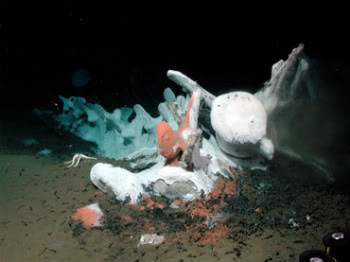The importance of a whale to the oceanic ecosystem does not end with its life. After dying, a whale’s body sinks to the bottom of the ocean and becomes food for many species, some of whom specialize on feeding on these corpses.
Using underwater cameras, researchers with the University of Gothenburg, Sweden have discovered nine new species of bristleworms feeding on dead whales. Related to the earthworm, bristleworms abound in the ocean, feeding on a variety of sources and living in many different habitats. However, the ones discovered on the whale are specialized feeders of bacteria that grows in thick layers on the cetacean’s bones.
Five of the new species were discovered feeding on whales bones off the coast of California. The other four were found in Kosterhavet National Park, off the coast of Stromstad, Sweden.
 Whale corpses, such as this one, are a vital and massive source of nutrients for many species. Photo by: Craig R. Smith. |
DNA analyses of bristleworms on the whale corpses also found several ‘cryptic species’. This means that despite looking identical, these animals actually differ enough genetically to be considered wholly different species. Such discoveries may have widespread implications for the estimated number of marine species in the world.
A dead whale provides a nutrient boom time for marine life in the area: researchers estimate that one corpse provides as much nutrients to the seafloor as would normally be found in 2000 years time. Because of this, the global decline in whale abundance—peaking in the 20th Century due to commercial whaling—has likely had a massive impact on the many species which depend on the nutrient booms provided by whale corpses.
Related articles
Gray whale populations a fraction of historic level
(09/10/2007) The current population of gray whales is one-third to one-fifth of the number found in the Pacific before industrial whaling began in the 19th century, reports a new study based on genetic analysis.
(11/30/2006) Iceland’s decision to resume hunting endangered fin whales raises an important question: how many whales are enough to sustain a population? While conservionists will debate over the actual number using varying models and population studies, a new paper published in the journal Bioscience attempts to establish a new system for setting population targets for threatened species.
Grey whales missing from traditional feeding grounds
(10/23/2006) Researchers found few grey whales in their traditional feeding grounds in the North Pacific last summer according to a scientist at the University of Bath. Dr. William Megill, a professor of mechanical engineering with special interest in biomimetics at the University of Bath, said that the absence of the 17,000 grey whales from traditional summer feeding grounds in the North Pacific could be cause for concern, despite the species’ recent removal from the endangered species list.